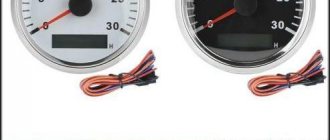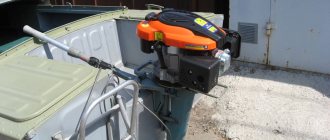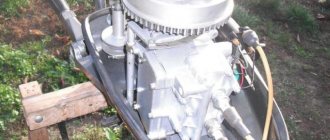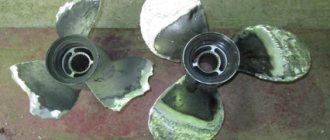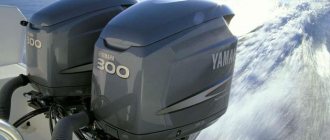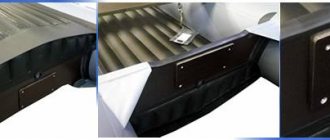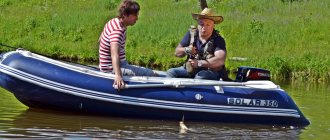Motor boats are popular both among fishermen and simply lovers of active recreation. In order for a swimming device to last a long time, it must be properly cared for. Preparing your outboard motor for winter storage is very important. If the basic rules are not followed, the risk that you will have to repair the engine when the swimming season begins increases significantly.
This motor was produced in the USSR, but such engines can still be found on boats to this day.
Main storage features
A boat motor consists of many metal parts, wires and a power supply. All these components are subject to the negative effects of condensation, sun, as well as dust and other contaminants. During active use, they are reliably protected by oil lubricant, which repels moisture, but during prolonged inactivity it dries out and disappears from the surface over time. This leads to the onset of corrosion.
If preparation for storage is carried out incorrectly or is completely ignored, then water, tarry deposits, and salts remain inside the engine. They can damage the wiring and power supply.
There are a number of simple rules on how to store a boat motor in winter. Here they are:
- protection against moisture and condensation - dampness is the first enemy of all metal parts. Therefore, it is important to choose a storage location with good ventilation. Do not wrap the motor in plastic film. Condensation may appear under it, which accelerates the formation of rust;
- sun protection - direct ultraviolet rays can negatively affect the performance of wires, so the motor should be located in a shaded place;
- protection from dirt – corrosion appears much faster under dust and other contaminants. It is necessary to thoroughly wash the motor before storing;
- engine preservation – makes winter storage safe, reduces the risk of malfunctions to a minimum.
Also, before preserving the engine, you need to carry out its maintenance. If any breakdowns are detected, they should be repaired immediately. This is necessary so that the problem does not worsen during the winter storage period.
Outboard motor without casing: you need to take care not only of what’s outside, but also of what’s inside
Preservation of the motor
Preservation of outboard motors begins from the moment of their last operation on the water. Immediately after sailing, rinse the engine thoroughly with clean water. Using a soft brush or sponge, remove all visible dirt and grease residues from the surface. Then, placing it in a vertical position, you should wait until all the water has drained.
The main stages of engine preservation include:
- Preparing the cooling system involves flushing with clean running water. For small motors (up to 4 hp) you will need a barrel. More powerful engines are flushed using special fittings that are connected to the water tap. The engine is left running at idle for 15 minutes. This time will be enough for the system to warm up well. It is important to monitor the water pressure. It must be stable and continuous;
- preparation of the fuel system - this stage is necessary in order to avoid contamination of the carburetor with resins. The fuel line is carefully disconnected from the engine and the engine is allowed to process the remaining fuel on its own. If the engine stalls immediately after turning on the starter, this indicates that the system has been completely cleaned. You can also remove fuel by removing the drain screw. This method is quite labor-intensive and requires skills in disassembling the motor. It is important to remember that you cannot turn on the motor in gear during the flushing process;
- use of a preservative – used to prevent the formation of corrosion. The special liquid or spray contains substances that protect all metal parts of the engine. Cylinders, bearings, and pistons must be treated with a preservative. In manually wound engines, the aerosol is injected into the spark plug holes. The preservative is poured into electric motors at the stage of preparing the cooling system;
- lubricant treatment - carried out to protect the screw shaft and gears from moisture. Any water-repellent lubricant will do. You also need to lubricate all moving bolts and nuts;
- changing the oil in the gear housing - necessary to ensure that old used oil with resins does not damage the metal;
- treatment of the engine surface - to keep it shiny and attractive, you can wipe it with automotive mastic.
To ensure the boat runs well, the propeller and shaft should be checked. If they are seriously damaged, complete replacement of parts may be necessary.
A serviceable propeller has no chips or large dents. Such damage disrupts the balance and reduces efficiency. Moreover, corrosion quickly forms at the chip sites. There should be no difficulty in removing the propeller from the propeller shaft. If you have to make an effort, this may indicate problems with the splines.
Why do you need to preserve your outboard motor for the winter?
Boat engines have a complex design with many units, parts and mechanical components. Naturally, for stable and long-term operation of the engine, excellent condition and clear interaction of all components of the device are important. And to achieve this goal, during long periods of downtime in the off-season, you should properly preserve the outboard motor. Let's look at what this process is.
So, preserving an outboard motor for the winter is an action to prepare the engine for the idle period, aimed at maximizing the service life of all components. Typically this procedure is carried out in several stages:
- Cleaning from contaminants.
- Flushing of systems;
- Motor lubrication;
- Treatment of the most vulnerable components with special protective equipment.
However, some owners of PLM limit themselves only to external cleaning of dust and dirt, and the purchase of a means for preserving the outboard motor. The engine is wiped with a damp cloth, the purchased spray is applied to the most vulnerable mechanisms, and this is where all preparation ends. And some users do not treat the motor with care at all: they say that imported devices are made using new technologies and all their protection is thought out automatically. But, unfortunately, often such people who rely on “brands” and “smart technologies” become the first clients of diagnostics and repair services for powerboats in the spring.
If you do not want to be among such “lucky” ones, then it is better not to listen to such advice and properly prepare your outboard motor for winter storage. Otherwise...let's find out in more detail what awaits those who are too lazy to preserve and leave the PLM stored without any preparation.
What happens if you don't prepare your boat motor for winter?
To find out the benefits of winter preservation, you need to understand a little about the specifics of the engine.
So, when the engine is actively used, it is protected from the appearance of “sores” by frequent use: components and assemblies are in motion, fuel and oil lubrication are constantly changed, moisture does not stagnate, and the engine itself is ventilated in fresh air, which also brings benefits. As a result, an oil film is constantly maintained on the leading parts and components, protecting the components from the effects of an aggressive aqueous environment and preventing the occurrence of corrosion and oxidation processes.
But during downtime, on the contrary, the outboard motor becomes vulnerable. The fact is that that same oil film becomes thinner over time, because... the components are stationary and there is no new injection of oil and fuel. And if at the same time the engine has not yet been thoroughly cleaned, then particles of fuel resins and oil, drops of trapped moisture and even sea salts remain inside. Accordingly, all these substances will oxidize unprotected metal parts over time and lead to the appearance of rust. As a result, after such “storage” the engine is guaranteed cylinder wear and significant loss of compression.
Long engine downtime is aggravated by winter temperature changes. The fact is that even the smallest particles of liquid remaining in the engine at minus temperatures turn into ice, which thaws with increasing temperature and leads to the formation of condensation. And the consequences of constant humidity and evaporation for a mechanical device can be the most unpredictable. From ordinary corrosion to water vapor entering the electronic unit and, as a result, a short circuit. And not every boat engine can be “revived” after such damage.
So it doesn’t matter whether the boat uses a branded engine from Yamaha, Tohatsu and Mercury or a budget Chinese one from SEA-PRO and Hankai - the preservation of the boat engine for the winter must be carried out. And it’s not at all difficult to implement, even if you’re new to this business. Moreover, a little later we will describe in detail how to properly preserve a boat motor for the winter. For now, let's look at one small nuance.
Is there a difference in the preservation of a two-stroke and a four-stroke engine?
So, for PLM, preparation for winter is necessary, but before we begin to describe it, let us dwell on one more important point. The fact is that two-stroke and four-stroke models of outboard motors are distinguished by conservative injection. And this difference is due to the design features of the units.
You may be interested: Outboard motor tax - tax rates by region, calculator
Two-stroke models are not equipped with a separate oil sump, so to provide a protective layer in the crank chamber, it is necessary to spray an outboard motor preservation spray through the carburetor diffuser. At the same time, the engine itself must be in working condition to achieve greater effect, i.e. turned on at idle speed. Another thing is boat motors operating in 4 strokes: their preservation is carried out without starting the engine, because the protective spray will easily cover all vulnerable components when the device is turned off.
Otherwise, the stages of preparing outboard motors for winter are the same, so let’s move on to a detailed description of the procedure.
Where should I store the motor?
You need to be very careful when storing your outboard motor during the off-season. Its performance depends on this. It is important to choose a location where it will be least exposed to negative external factors. Therefore, the place should be clean, dry and warm.
Here is one option for storing outboard motors in the garage
Most often, storage of outboard motors in winter is organized in a garage, apartment or on the balcony. Owners are often forced to leave engines in the cold. Of course, this storage method is quite risky. Still, it’s worth trying to find a more suitable option.
Garage storage is convenient because it is very easy to organize. Moreover, even the engine preparation can be carried out here, so there will be no problems with transportation.
The outboard motor must be stored in an upright position. To do this, it can be hung or placed on a special stand. It is important to follow this rule to avoid damage.
Another engine mount option
If the garage is not heated, be sure to cover the engine with a thick cloth or blanket. Synthetic materials do not allow air to pass through well and can increase the amount of condensation. In addition, do not cover the motor with polyethylene. The fabric must be natural.
To prevent rust formation, it is necessary to wipe the engine with a dry towel several times during the winter season. It is especially important to do this during periods of strong temperature changes outside.
Storage in an apartment is a safe method, which, unfortunately, is not available to everyone. Not every home has room for a large enough motor. Moreover, like other equipment, it emits not very pleasant odors of oils, grease and fuel, so not everyone will appreciate such a proximity.
When leaving the motor in the apartment, you need to allocate a place for it away from the window. You should not cover it with blankets; you can use a special case for storage. It does not allow light and dust to pass through. Storage in an apartment has several advantages:
- stable air temperature, no changes;
- comfortable humidity;
- the ability to regularly inspect the motor if necessary.
If there are no other options, you can leave the engine on the balcony, but in order to avoid rust, you need to carefully prepare the engine for such wintering.
Preservation of outboard motor (winter storage)
Preservation should be carried out regardless of the temperature of the room in which the motor will be stored!!!
The first thing you should do when preparing your outboard motor for long-term storage is to check that there is no water in the cooling system. The engine must be installed on a special rack or some kind of stand and, having disconnected the wires from the spark plugs, crank it using a manual starter so that the water remaining in the channels of the cooling system pours out.
Please note that this may not always completely remove water from the engine cooling system passages. Therefore, it is better to store your outboard motor not at sub-zero ambient temperatures, but in a dry, heated room. Under such conditions, rubber and plastic parts are also better preserved.
After which you need to clean the engine from dirt and dust, rinse all external surfaces well with gasoline or kerosene and wipe dry. If necessary, engine parts should be cleaned of carbon deposits.
There is a way to clean carbon deposits without disassembling the engine. To do this, a mixture consisting of 20% oil and 80% kerosene is poured into each cylinder of a hot engine, installed with the spark plug holes up so that the pistons cover the exhaust ports of both cylinders. Then screw in the spark plugs and leave the engine in this position for 10-12 hours. Then the mixture is drained and the engine is started for 20-30 minutes. During this time, the soot softened by the mixture burns out.
Next, they begin to actually preserve the outboard motor. The engine is warmed up and placed with the spark plug holes facing up, the pistons are set alternately to the bottom dead center position and 50-70 cm3 of clean dehydrated MS-20 aviation oil is poured through the spark plug holes. Allow a holding period of 1-2 minutes and smoothly turn the crankshaft by the flywheel three to four turns. After this, the outboard motor is placed in a vertical position and the crankshaft is additionally turned by the flywheel two to three turns. The spark plugs, cleaned of carbon deposits, are installed in place.
You can use another method of preservation. The engine is started and warmed up to operating temperature. After this, the fuel hose from the gas tank is disconnected from the engine. Using a syringe, 80-150 cm 3 of automotive oil is injected directly into the carburetor mixing chamber in small portions until the engine stops. The oil mist formed in the crank chamber evenly lubricates all critical engine parts.
After conservation, plugs made of wood or paper should be placed in the holes of the deadwood and carburetor. The gearbox cavity must be washed with clean gasoline and filled with fresh dehydrated lubricant. Dehydration of oil occurs when it is heated to 105-110 0 C and held until foaming and cracking stops. The propeller should be removed, lubricate the propeller shaft with a thin layer of grease and put the propeller in place. The friction points of the external parts must be lubricated with grease.
Boat motors equipped with an electric starter require more attention during storage than manually started motors. If the boat is stored outdoors, it is recommended to remove the remote control with electrical wires and store it in a dry place.
The battery cannot be “turned off” between seasons. It suffers less wear and tear if stored in a cool place, but be aware that the electrolyte in a discharged battery may freeze. It is better to store the battery indoors, protecting it from moisture. Batteries with less than half the electrolyte content must be recharged. It needs to be recharged at least once every two months, otherwise it will discharge and fail.
We do not recommend saving money by trying to save unused fuel from one season to the next. At the end of the season, you should empty the fuel tank and flush it with clean gasoline, as the remaining oil can form a tarry substance over the winter months. It is recommended to store the tank in a dry, protected place with the filler cap removed.
Do not cover the engine, battery or fuel tank with a sealed casing or film; Under such protection, condensation may form, which will cause rusting of parts.
As a result of preservation, the engine will be protected in the form of an oil film, but it is recommended to turn it manually at least once a month during the winter, which will ensure that the protective film remains on the surface of the parts.
The storage period is the time when it is necessary to thoroughly inspect the outboard motor, tighten fasteners and check items such as fuel lines, high voltage wires in the ignition system, and other parts subject to damage and wear.
The above tips for storing outboard motors in winter can be summarized in a certain order of work:
1. If the outboard motor was operating in sea water, let it run for some time in a tank of fresh water (to remove salts) and wash off the salts from the external surfaces;
2. Drain the water from the cooling system;
3. Disconnect the fuel supply hose from the engine;
4. Drain the fuel from the tank and carburetor. Rinse the tank with clean gasoline, then pour in 0.5 liters of oil, shake it and drain;
5. Wipe the outer surface of the parts dry, and then wipe the unpainted parts with an oiled rag;
6. Remove the propeller, lubricate the shaft and install the propeller in place;
7. Drain the oil from the gearbox and rinse the gearbox with clean gasoline;
8. Fill the gearbox with dehydrated gear oil;
9. Lubricate the friction points of the external parts with grease;
10. Unscrew the spark plugs and install the engine with the spark plug holes up and tilted towards the purge windows (towards the fuel pump). Set the pistons one at a time to the bottom dead center position and pour 50 cm of clean dehydrated engine oil into the cylinders through the spark plug holes. Allow 1-2 minutes with each pistons positioned at BDC for oil to flow into the crankcase, then crank the engine from the starting mechanism 3-4 times. Place the motor in its normal position and turn it 3-4 more times. Lubricate the intake valves by pouring 15-20 cm of oil through the carburetor; in this case, place the motor so that the partition with the valves is in a horizontal position, and then, tilting it in different directions, ensure that all valves are lubricated;
11. Remove the flywheel and lubricate the upper end of the crankshaft, shoes and flywheel bushing with a thin layer of oil. After this, install the flywheel in place and secure it;
12. Clean the spark plugs from carbon deposits, lubricate the threads with oil and put them in place;
13. Place paper or wood plugs in the carburetor holes and spacers.
How to make your own engine stand?
A boat motor stand is the most convenient and safest way to store it. Thanks to it, the engine is well fixed in a vertical position. The storage stand reduces the risk of the motor falling and therefore being damaged. It is also convenient to use such racks for engine repairs, since all its parts are in plain sight.
You can buy such a device at a specialized store or, even better, make it yourself. To create a stand you will need:
- profile pipes, preferably steel;
- welding machine;
- durable plywood for the base plate;
- bolts, nuts;
- wheels for ease of movement.
There are many options for this design; one of the simplest designs is a stand with a height of 90 cm on two support legs. The motor is attached to a plywood plate. It can be made double and thereby significantly strengthened. This plate will withstand heavier motors. The finished rack is painted with paint, protecting it from rust.
You can make the stand yourself from metal or wood
If you have no experience with welding, you can make a stand from wood. For this you will need:
- durable wooden beams, preferably oak;
- liquid Nails;
- wooden base plate;
- bolts, nuts.
This stand is much easier to make. You don’t even need special knowledge and skills for this. All its parts are fastened together with bolts and fixed with glue. The finished stand must be varnished so that the wood retains its properties longer.
In general, the conservation and storage of a boat motor should be organized so that it does not have to be repaired after the winter season. By adhering to the basic rules, you can not only avoid breakdowns, but also significantly extend the life of the engine.
What is the best way to store an inflatable boat?
